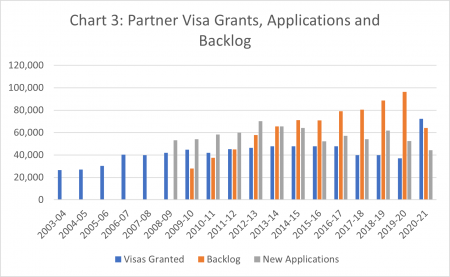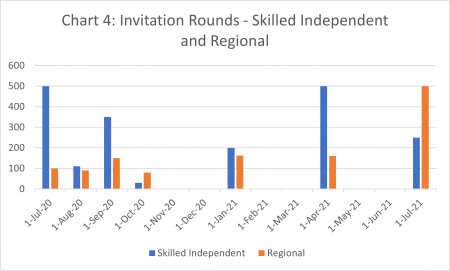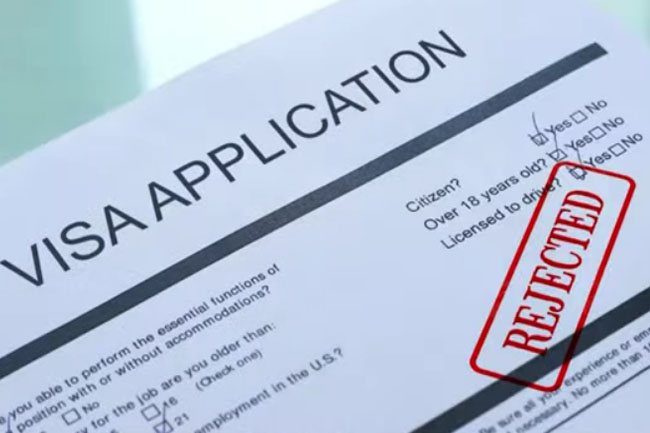Immigration Minister Alex Hawke has at last released the report on the outcome of the 2020-21 Migration Program — months after he would have received it.
The 2020-21 Migration Program was delivered at 160,052, almost 20,000 more than in 2019-20 and only slightly above the “ceiling” of 160,000. Thankfully, Hawke has stopped playing Defence (and former Home Affairs) Minister Peter Dutton’s silly ceiling game and resumed using the planning level as its target (see Chart 1).

There were three key features of the 2020-21 Program.
Firstly, a shift in the balance of the program away from the skill stream to the family stream with only 50.7% of the program going to the skill stream. At 79,620, this was the smallest skill stream since 2004-05. Contrary to suggestions in The Australian, this shift in the balance to the family stream was not due to COVID-19 but because the Government at last stopped (unlawfully) restricting the number of places for partner visas and instead delivered the largest partner category in Australia’s history at over 72,000.
Secondly, a record 71% of the program went to people already in Australia. That was indeed the impact of COVID-19 due to a reluctance to grant offshore visas that would put added pressure on the international arrivals cap. The portion of onshore visas in the skill stream was even higher than the previous record of 69% in 2019-20 (see Chart 2). In the ten years prior to 2019-20, the highest portion of the program delivered to people onshore was 59% in 2013-14. The large portion of the program going to people already in Australia has contributed to the significant decline in temporary entrants in Australia.

Thirdly, there was a phenomenal increase in approval rates.
For example, the approval rate for partner visa applications increased from around 90% in recent years to 98% in 2020-21. The approval rate for employer sponsored visas increased from around 85% in 2017-18 to 97.6% in 2020-21. For Regional Employer Sponsored visas, the approval rate increased from around 61.2% in 2017-18 to 93% in 2020-21. There has also been a similar increase in approval rates in student and temporary entry categories.
Part of the increase in approval rates would relate to a shift from the Peter Dutton era where decision-makers were refusing applications for even the most minor issues to a more balanced approach. But that is not a sufficient explanation for the degree of increase in approval rates in 2020-21.
It is possible that decision-makers have been instructed, without this being made public, to ignore minor issues in visa applications and to only refuse an application if there is a substantial concern. Taken too far, this approach can result in a significant loss of integrity in the visa system.
Another possible explanation is that decision-makers have been instructed to put aside applications headed for refusal. Refusal decisions inevitably take much greater resources to finalise. But these cases have to eventually be processed and that will soak up resources as well as leading to a surge in appeals to the Administrative Appeals Tribunal (AAT). The high approval rate in 2020-21 led to general migration appeals to the AAT falling sharply in 2020-21.
Whichever is the explanation, it reflects poor administration.
Source countries
For the first time in over a decade, China (22,207) overtook India (21,791) as Australia’s main source of immigrants. This was predominantly due to the larger portion of visas granted in the partner and business skills categories which have higher levels of demand from China and a lower portion in the skilled independent category which has a higher level of demand from India.
The other two big movers were migrants from the USA (4,780 visas in 2020-21, moving from tenth place to sixth) and Hong Kong (4,312 in 2020-21, moving from 23rd place to eighth). Major source countries that maintained their position were the UK (12,703 at third); the Philippines (11,058 at fourth); and Vietnam (8,120 at fifth).
Intended state/territory of residence
In line with the larger migration program in 2020-21, the number of migrants intending to settle in each jurisdiction was generally higher than in 2019-20.
At 50,417, the number of migrants intending to live in NSW was well above the 44,182 in 2019-20 but below the average of recent years of over 55,000 (61,742 in 2015-16).
Victoria had 39,170 in 2020-21 compared to 34,189 in 2019-20. Western Australia received 15,994 in 2020-21 compared to 11,377 in 2019-20.
Queensland increased from 18,743 in 2019-20 to 22,903 in 2020-21. The 2020-21 level for Queensland was the highest in over ten years.
For all other jurisdictions, the number of migrants in 2020-21 was down on the level for 2019-20. At 9,769, the level for South Australia was the lowest in over ten years.
Major occupations
Within the skill stream, the top five occupations were registered nurse (3,670 primary visas and predominantly nominated by state/territory governments); software and applications programmers (3,121); accountants (2,065); ICT business and systems analysts (1,108) and civil engineering professionals (1,106).
Partner visas
The partner category was delivered at a record 72,376 visas. Australia has never before issued more than 48,000 partner visas in a single year (see Chart 3). Of the 72,136 visas in 2020-21, 49,180 went to people already in Australia and 23,196 to people overseas (or at least people who lodged an offshore partner visa application even if they were actually in Australia while their application was being processed).

(Source: Home Affairs website, Migration Program Reports)
The 98% approval rate would be the result of either instructions to decision-makers to take a more lenient approach to the “genuine relationship” test to meet the planning level or decision-makers have put aside a large number of applications destined for refusal (which itself is a legally dubious action). Once those applications are finalised, we may see a surge in appeals to the AAT.
Nevertheless, the record partner visa grants of 72,376 in 2020-21, as well as a sharp fall in new applications to 44,325, enabled the backlog to be reduced to 64,111 — the smallest partner backlog since 2012-13 (note there are also 4,567 partner cases at the AAT where there is a set-aside rate of almost 60%).
With another 72,000 places allocated to partners in 2021-22 and new applications likely to continue to trend downwards due to the international arrivals cap and fewer temporary entrants in Australia (less opportunity for young Australians to meet young non-Australians), it is quite possible the Government may be able to reduce the backlog to much more manageable levels by end 2021-22 (possibly well below 40,000 and below the annual application rate).
That would enable the Government to shift the balance of the program back towards the skill stream from 2022-23.
Skill stream
The outcome for the skill stream of 79,620, the smallest since 2004-05, was broken down as follows:

All the indications are that the skill stream will be larger in the second half of 2021-22 and certainly in 2022-23 once the partner backlog is further reduced. Moreover, a larger portion of the skill stream is likely to be delivered from offshore although this may take time to build up from 2022.
Employer sponsored
The steady decline in employer sponsored visas is a function of the ham-fisted policy and administrative tightening introduced by Peter Dutton in 2017-18. The brief recovery in 2018-19 was due to clearance of a backlog created by the shift to a “refusal” mindset (visa refusals take much more resources than approvals as well as the risk of appeals being set aside at the AAT).
The application rate for permanent employer sponsored visas has trended down since 2017-18 when there were almost 35,000 applications. This fell to just below 25,000 applications in 2020-21. The number of permanent employer sponsored applications on hand is 14,379, but a larger than usual portion of these may be headed for refusal.
A key to the number of permanent employer sponsored visas granted in 2021-22 will be the number of people holding skilled temporary visas (formerly SC 457 and now SC 482). Skilled temporary visas granted in 2020-21 were down 18.5% compared to 2019-20. The number of skilled temporary entrants granted permanent employer sponsored visas in 2019-20 was 25,410. In 2020-21, this fell to 19,410.
Without a very tight labour market and the changes to policy for these visas as recommended by the Joint Standing Committee on Migration, the number of permanent employer sponsored visas granted in 2021-22 is unlikely to exceed the 23,503 granted in 2020-21 and may even fall short of this level.
In 2020-21, this category was predominantly used to recruit software and applications programmers, registered nurses, accountants, ICT business and systems analysts and university lecturers.
Regional Employer Sponsored
The changes made to this category under the 2019 “Population Plan” issued by the Prime Minister has sharply driven down demand in this category.
The outcome has fallen from 6,221 in 2017-18 to 2,910 in 2020-21. Applications have declined from 17,003 in 2017-18 to 3,032 in 2020-21 and cases on hand have fallen from 24,362 to 3,144 at end 2020-21.
While the approval rate has increased dramatically from 61.2% in 2017-18 to 93.1% in 2020-21, it is highly likely this category will continue to trend downwards. The new version of this category is now mainly used by regional restaurants to recruit cooks, retail managers and café and restaurant managers.
State/Territory Nominated SC 190 and Regional SC 491
The outcome for this SC 190 in 2020-21 was 14,268, down from 21,495 in 2019-20. New applications also fell from 20,512 in 2019-20 to 15,904.
The decline in this direct permanent resident category needs to be considered in conjunction with the outcome for the Regional State/Territory Nominated provisional category (SC 491) which increased from 1,500 in 2019-20 to 10,675 in 2020-21.
It appears that either DHA is encouraging state/territory governments to make greater use of the provisional category or state/territory governments have decided to do so themselves.
DHA has more than 18,000 applications in the Regional SC 491 visa category on hand while the refusal rate for this category has declined from 6.1% in 2018-19 to 2.3% in 2020-21.
State/territory governments appear to have received increased allocations for these visas in 2021-22 and have indicated they will use these allocations almost entirely for people already in Australia (at least until international borders open).
State/territory governments used both the permanent residence and provisional categories for registered nurses, software and applications programmers, accountants, ICT business and systems analysts, medical practitioners and engineers.
Skilled Independent (SC 189)
Perhaps the most significant change in the composition of the migration program in recent years has been reduced usage of the skilled independent category which has declined from 39,137 visas in 2017-18 to 7,213 visas in 2020-21.
Invitations under the skilled independent category have become both smaller and more sporadic (see Chart 4). This trend is likely to continue through 2021-22.

At this stage, recovery in this category will be gradual and subject to the timing of international travel resuming and clearing of the partner backlog. The category may recover more quickly from 2022-23, especially if the labour market is very strong and the Government proceeds to increase the size of the Migration Program to 190,000 from 2023-24 as assumed by Treasury.
Business Innovation and Investment Program (BIIP)
The BIIP outcome for 2020-21 of 11,198 is the highest for well over a decade and almost three times larger than the outcome for 2019-20. It may be the largest BIIP outcome on record.
This is again the result of attempted backlog clearance. The refusal rate fell from 13.9% in 2019-20 to 6.4% in 2020-21. Despite the record increase in BIIP visas granted, the backlog at end 2020-21 was still almost 32,000.
In 2020-21, 15,818 applications were received which means the Government will need to allocate a significant number of places to the BIIP in 2021-22 and beyond. The investor visa and significant investor visa streams of the BIIP are essentially a “buy a visa” scheme.
From July 2021, the Government has converted all BIIP visas into two-step visas where the initial visa is a provisional five-year visa subject to various performance requirements. This will lead to a decline in the application rate, particularly from China.
Global Talent Independent (GTI)
The outcome for the GTI visa in 2020-21 was 9,584, a substantial increase over the outcome for 2019-20 of 4,109. However, the 2020-21 outcome was well down on the announced planning level of 15,000.
This shortfall is not surprising given the extent to which the Government has stretched interpretation of the legal requirement that applicants have an ‘internationally recognised record of exceptional and outstanding achievement’.
Traditionally, Australia has struggled to attract more than 200 such applicants. Most applicants receiving a GTI visa would qualify for other skill stream visas unless they are particularly old. But they would prefer a GTI visa as processing is rapid and there are very few other pre-visa requirements (it does not even require applicants to have a recognised qualification or English language skills) and no post-visa performance requirements. The GTI is indeed ripe for cronyism and corruption.
Moreover, it is not really a “global” visa given around 77% of visas were granted to temporary entrants already in Australia.
It would be very surprising if the Government allocated more than 10,000 places to this visa in 2021-22. In terms of good administration, the allocation should be significantly less.
Dr Abul Rizvi is an Independent Australia columnist and a former Deputy Secretary of the Department of Immigration. You can follow Abul on Twitter @RizviAbul.
Related Articles
- Bridging visa boom sparks audit request
- Temporary entrants in Australia: Who is left and what is to come
- Rules around travel exemptions unclear, stranding Australians
- COVID-19 saving AAT from burgeoning backlogs
- Agriculture Visas: Modern slavery continues
 This work is licensed under a Creative Commons Attribution-NonCommercial-NoDerivs 3.0 Australia License
This work is licensed under a Creative Commons Attribution-NonCommercial-NoDerivs 3.0 Australia License
Support independent journalism Subscribe to IA.














